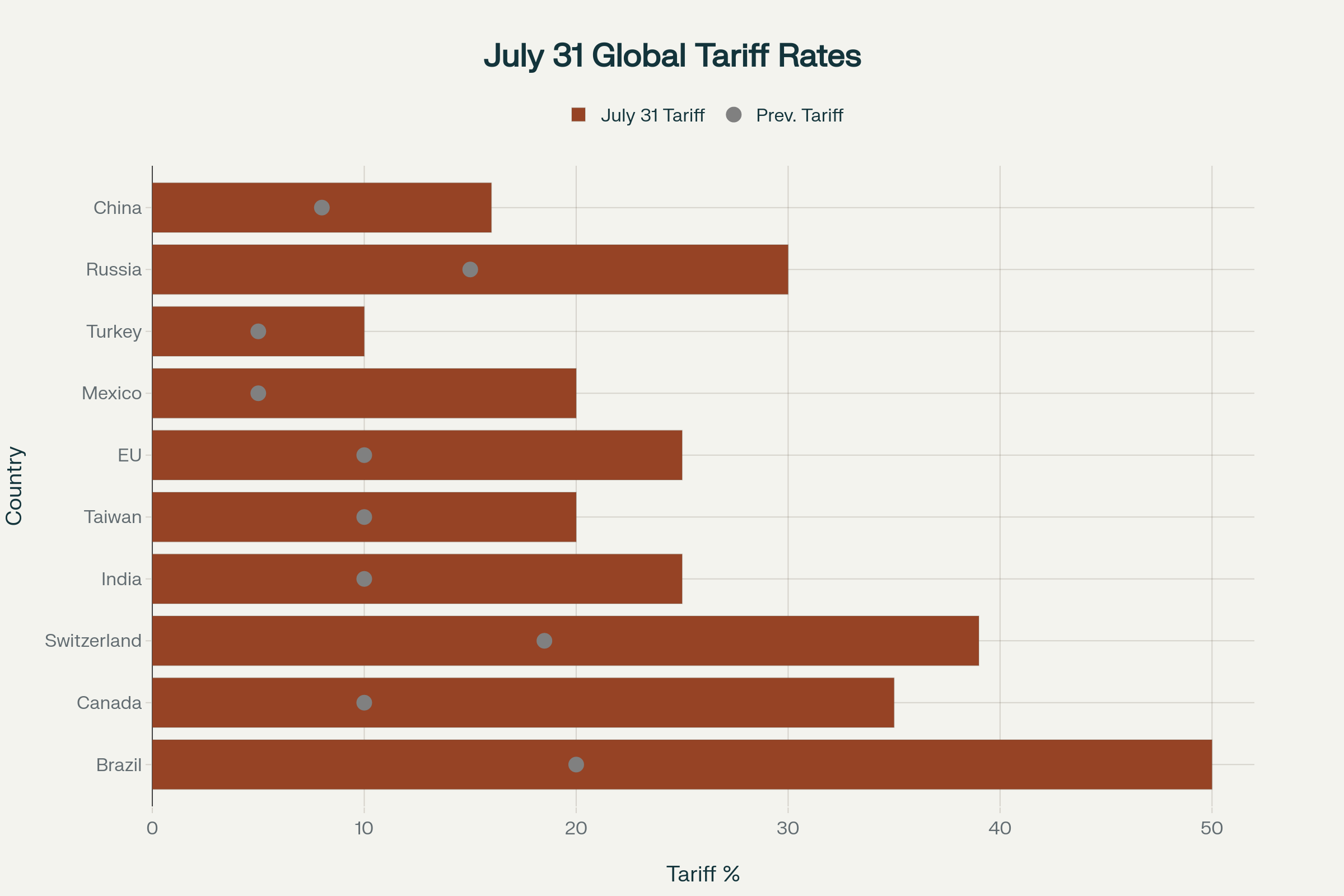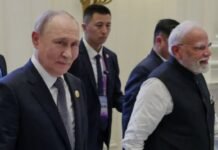Saptrishi Soni: In an extraordinary escalation of economic brinkmanship, U.S. President Donald Trump’s most recent wave of tariffs—set to take effect on August 7—has sent shockwaves across global markets and left rival economies scrambling to recalibrate their strategies. These new tariffs, the steepest imposed by the U.S. since the early 1930s, have injected a potent mix of uncertainty, urgency, and strategic rethinking into international trade relations.
Markets responded with sharp volatility, highlighting investor anxiety about the direction of global commerce. Trump’s high-stakes maneuvering comes at a time when countries had begun stabilizing from previous rounds of tariff threats. Now, with the White House announcing new rates that soar to 39% for Switzerland, 35% for Canada, 25% for India, and 50% for Brazil, the international community has been pushed into a defensive posture, activating emergency negotiations and, in some cases, exploring alternative economic alliances.
Canada, burdened with a 35% duty on a broad array of goods, is one of the hardest hit. Canadian negotiators, while holding out hope for a deal, have warned that any resolution may still be weeks away. Meanwhile, Switzerland, described by officials as “stunned” by the 39% rate, is urgently seeking diplomatic talks with Washington to mitigate the trade blow. Brazil, confronting a staggering 50% duty, and Taiwan, facing a 20% tariff (which it has described as temporary), have also initiated rounds of bilateral discussions in an effort to defuse tensions.
The new tariffs underscore the Trump administration’s determination to fundamentally reorder the global economic landscape. The White House insists its approach is a necessary correction to decades of what it considers unfair trade practices, vowing to spur the return of manufacturing jobs, rebalance trade deficits, and strengthen the domestic industries that have long been at the heart of America’s economic identity. Trump’s rhetoric, echoed by senior administration officials, is unyielding: these measures are not just economic weapons—they are levers to force trading partners to the negotiating table and secure what are cast as more equitable agreements.
Yet, the immediate consequences are reverberating well beyond American borders. Exporting nations are finding themselves squeezed between the urgent need to retain access to the world’s largest consumer market and political imperatives at home, where job losses and industry disruption can quickly morph into domestic unrest. Companies caught in the crosshairs face decisions about whether to absorb cost hikes, pass them on to consumers, shift supply chains, or seek less exposed markets. For many, the prospect of a prolonged standoff has swiftly transitioned from a distant risk to a business-defining reality.
The broader implications are profound. Tariff shocks on this scale have historically set major economies on divergent paths, prompting a reevaluation of strategic alliances and accelerating the formation of new regional trade pacts. Indeed, as the weight of American tariffs becomes clearer, key U.S. trading partners—from Europe to Asia—are already discussing ways to reduce their exposure to Washington’s trade policy volatility. This could mean deeper ties between affected nations themselves, as well as a shift toward robust regional blocks designed to counterbalance U.S. leverage.
While the Trump administration maintains that these moves are essential for restoring American economic primacy, their impact is likely to generate significant debate in the months ahead. Proponents argue that decisive action against perceived trade abuses is both timely and necessary—a corrective to patterns that have hollowed out domestic industries and undermined self-sufficiency. Supporters contend that tariff-driven disruption, though painful in the short run, can catalyze overdue reforms, ignite innovation, and compel businesses to adapt, ultimately fostering a more self-reliant and resilient economy.
At the same time, history teaches that protectionist waves, if unchecked, risk fragmenting global commerce, fueling retaliatory measures, and triggering competitive devaluations. But within the turmoil lies opportunity: the crisis set off by Trump’s tariffs may prompt both the U.S. and its adversaries to rethink long-held trade assumptions, invest in more balanced economic structures, and, eventually, arrive at a more sustainable global trade order.
For society at large, such dramatic interventions carry dual promise and peril. If managed well, they can serve as catalysts for job creation, the revival of national industries, and renewed bargaining power for ordinary workers. They can also inspire countries to innovate and diversify, setting in motion a virtuous cycle of competition, productivity, and growth that benefits society. Ultimately, this phase of economic upheaval—fraught though it may be—offers nations the chance to build more just, resilient, and future-proof economies, provided governments and business leaders are willing to seize the moment.

Tariff Rates on General Products Announced by U.S. on July 31 compared to Previous Tariff Threats
#TrumpTariffs #GlobalTrade #EconomicNationalism #IndiaUSRelations #USChinaTrade #CanadaUSTrade #TariffWar #TradeDiplomacy #GlobalMarkets
This is an auto web-generated news web story.




